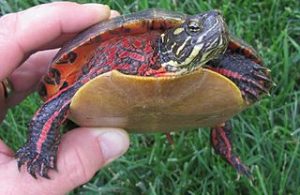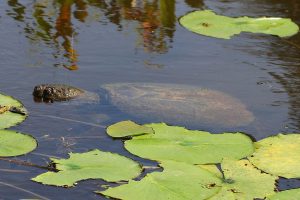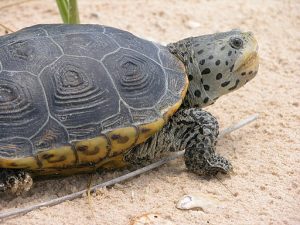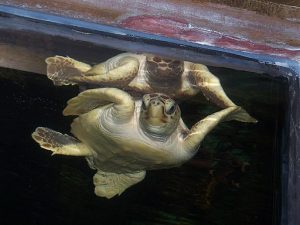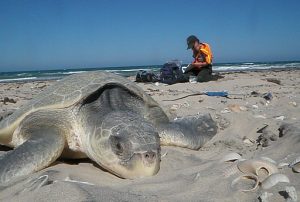Turtles are ancient reptiles that first walked the Earth millions of years before the first dinosaur. How could such a strange, primitive creature survive for so long? The answer is their wonderful, durable shells! All turtles have shells on their backs that are linked to their skeletons’ ribs, providing them protection from the claws and jaws of predators for their entire lives--which can be very, very long. With this shield, they have survived in many environments, from wetlands to desert, and even the open ocean. Though they come in different shapes and sizes, all turtles rely on their shells to help them survive, including the turtles of Virginia. Join us as we look at the turtle species of Virginia, their roles in the ecosystem, and how to help conserve them.
Turtles of the Rivers and Land
There are several species of turtles that live in the Fredericksburg area, but only one lives on land. The eastern box turtle is a turtle species that lives in most states east of the Mississippi River in a variety of habitats, including the woods of Fredericksburg. This turtle can easily be identified by its high domed shell, which is usually brown with orange, yellow, or red markings. They are typically active during the day and live within a range of 200 meters of their birthplace. Box turtles eat a wide variety of food, ranging from slugs to blackberries to poison mushrooms, which the turtle can digest without getting sick. Their ability to retract their legs and head completely within their shell means they have few natural predators, and they can potentially live over 100 years! Sadly, many box turtles don’t live this long anymore; loss of habitat and deaths by cars have reduced the number of box turtles enough that this is now considered a vulnerable species. A turtle census has been launched in Virginia to better understand how Virginia’s development has impacted the box turtle within the state and what methods can be used to preserve them. As you wait for the turtle census to finish, you can help by leaving any box turtles you find in their home ranges in the woods--they’ll do much more for the ecosystem there than as pets!
The Fredericksburg area’s many rivers, lakes, and streams make it an ideal habitat for Virginia’s water-dwelling turtles. The most common of these is the eastern painted turtle, a frequent sight in any slow or still body of water. These turtles have a long, oval-shaped shell that is olive colored, with red lines on the shells and edges. Photos are often shot of painted turtles during sun basking in their daily routines, made easier by the fact that this turtle’s basking always occurs in the early morning. They may rest on top of each other during their basking, making the painted turtle a likely source of the local “turtle stack” image that became popular online in 2020. This turtle only leaves its home river or lake if it is forced by drought to migrate, and its main natural predators in the Fredericksburg area are bald eagles and raccoons.
Despite being cold-blooded, these and other turtles can survive Virginia’s cold winters by slowing their metabolism to 10 percent of their normal rate. Unlike the true hibernation practiced by other animals, which involves deep sleep, turtle hibernation or brumation allows the turtle to stay awake and aware of the world, even while in an immobile state of torpor. Water turtles will remain awake even when frozen beneath the ice, whereas box turtles will dig a hole to safely hide in as the temperature falls. When the sun begins to shine brightly again and temperatures rise, the turtle will sense it is time to be active once more.
The common snapping turtle is another of Fredericksburg’s water turtles, but it is considerably larger and more dangerous than the red-eared slider. They have shells that can range in color from dark brown to black, often becoming covered in algae as the turtle ages, and a large head with a pointy hooked beak. They prefer to stay in water, where they will eat a wide variety of food, including aquatic plants, algae, catfish, frogs, and even waterfowl, such as ducks. Unlike the painted turtle and box turtle, the snapping turtle may potentially travel great distances from its home range to lay eggs or find a new territory; females may travel a mile to find an ideal nest site. Their large size, strong shell, and powerful bite mean the adults have few natural predators other than humans, although crows, raccoons, and foxes will attempt to eat hatchlings.
One type of turtle that used to be important to the Fredericksburg area in decades past is rarely mentioned now. The diamondback terrapin is native to Virginia and still occurs in the Chesapeake Bay and the wetlands near Chincoteague, but it prefers water that is more brackish (salty) than the Rappahannock itself. The diamondback was once quite common in the Chesapeake, and fishermen from our area traveled out into the Bay in search of the turtle. Turtle soup was an extremely popular dish at most hotels in and around Washington, and fishermen could make a considerable profit from their catch, especially as the terrapin became increasingly rare. The terrapin population was decimated by overfishing, and turtle soup only lost its popularity with the onset of Prohibition, as sherry (a key ingredient in the soup) was banned. Decades after the commercial fishing of terrapins ended, the diamondback is still considered a vulnerable species, and its population has never recovered to pre-turtle soup numbers in the Chesapeake.
Voyagers of the Seven Seas: Virginia’s Sea Turtles
Two species of sea turtles regularly appear in Virginia waters, although neither nests in the Fredericksburg area. The more common of Virginia’s sea turtles is the loggerhead. They are large turtles that weigh about 300 pounds on average and have a reddish-brown shell. Adult loggerheads are rare in Virginia waters, though; most loggerheads in the Chesapeake are only about 28 inches long, whereas the adults are about 3 feet long. Though the juveniles often venture into the Chesapeake to feed on horseshoe crabs, loggerhead nesting is rare in Virginia, and only a few single females each summer will choose land on Virginia’s beaches to nest upon. Virginia is the northernmost place where loggerheads can typically nest, although their swimming range is quite large and extends even farther north than the Chesapeake. Loggerheads are considered an endangered species, and any nests discovered in Virginia will be protected by the government to give the hatchlings a fighting chance to get to the sea.
The other of Virginia’s sea turtles is even rarer than the loggerhead. About 200-300 Kemp’s Ridley sea turtles visit the Chesapeake every year. The Kemp’s is much smaller than the loggerhead, reaching a length of two feet and weighing only 100 pounds at maximum. The Kemp's Ridleys that appear in Virginia waters are almost all juveniles that are about 15 inches long; adults are almost never sighted here. Kemp’s do not normally nest in Virginia, and almost all of their nesting sites are in northern Mexico. In addition to their smaller size, their olive green shell color is also quite distinct from the reddish-brown loggerhead shell. They are considered a critically endangered species, so any sighted should be protected!
Turtle Do’s and Don’ts
Many of Virginia’s turtles face dangers to their survival, and there are a number of things you can do to help them. One of the most important things you can do for them is to not take wild turtles as pets. Some inexperienced people take box turtles from the wild and try to keep them as pets without looking into their needs; this reduces the number of wild turtles and may also put the turtle’s life at risk. The Fredericksburg area’s other turtles live in the water, so try to keep our lakes, rivers, and streams as clean as you can to provide a good habitat for them. Virginia’s sea turtles need protection, too, and they may get strangled in fishing nets or injured by boats; if you see an injured sea turtle, call 757-385-7575 for the Virginia Aquarium Stranding Response Program. Sea turtle nests are even more vital for the survival of the species; you can report them to organizations like NEST (North Carolina/Virginia border) and VIMS (Virginia Beach) so they can be protected and mapped.
The population of turtles in Virginia has shrunk over the decades, and many species are now threatened by habitat and population loss. For a long time, people took the existence of turtles for granted, and it was not unheard of for a 100-pound sea turtle to end up on the menu in one of Fredericksburg’s downtown hotels. We must now make up for lost time and preserve our state’s turtles for the future. By leaving turtles in the wild, supporting attempts to save turtle habitat, such as Crow’s Nest, opens a new window, and working with sea turtle conservation groups to protect nests, we can better protect all of Virginia’s turtles for many years to come.
Here are some books on the kinds of turtles you can find in Virginia--and more from around the world--for both younger and older readers.
Includes photos, species descriptions, and ranges of all the turtles in Virginia.
Explains how people are attempting to save the Kemp's Ridley sea turtle and other sea turtles.
"Describes the life of Lonesome George, the last living Pinta Island giant tortoise, from his search for food on the Galapagos island to his days at the Charles Darwin Research Station, where scientists are encouraging him to mate." (Not a Virginia turtle, but one of the most important turtles in the world).
Describes the types of North American box turtles, how they evolved, what makes them different, and how they became endangered.
Picture book for young children depicting a baby turtle's hatching and escape into the sea.
Describes all the eight kinds of sea turtles in the world and how people keep them safe.
Explains how sea turtles evolved, what makes them distinct from other turtles, and their life cycle, from hatching to adulthood.


